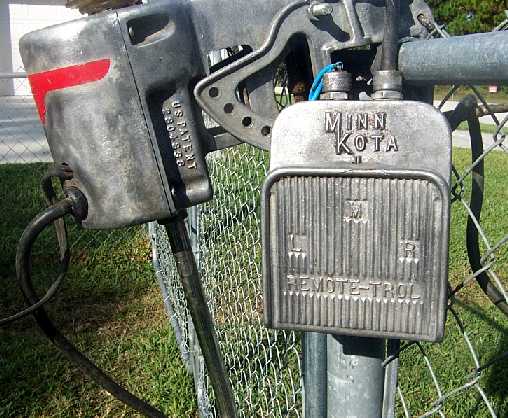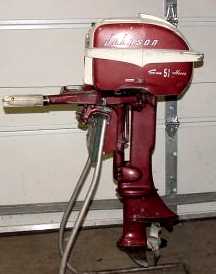|
|


SKEETER HAWK PROJECT
PART 6
'Peripherals and Stuff - A History Lesson'
Our antique Skeeter Hawk requires a few more things than just a repair and refinish facelift. It also requires that we make it 'fishable'.
That means we need a main engine, a trolling motor of some type, and a depthfinder. Of course, we then need a trailer to haul it around.
Trailers are easy to come by. We just have to look around and find either a good buy on a new one, or a used one in good condition. The bottom line is that it must be safe and roadworthy, in addition to fitting the boat.
The remainder of the items became a little difficult because we wanted to keep the boat and all its accessories true to the era of the original hull. That meant we needed accessories that would have been around in the 1958 - 1962 timeframe to preserve our antique boat authenticity.
We have them. It took a lot of digging and calling, but we came up with authentic accessory antiques. And, all are fully functional, too!
Many of you have probably never seen these items and may have never even heard of them. So, in addition to following our project, you may just get a bit of a fishing history lesson, too.
In the late 1950s, Carl Lowrance and his sons Arlen and Darrell began scuba diving to observe fish and their habits. This research, substantiated by local and federal government studies, found that about 90 percent of the fish congregated in 10 percent of the water on inland lakes. As environmental conditions changed, the fish would move to more favorable areas. Their dives confirmed that most species of fish are affected by underwater structure (such as trees, weeds, rocks, and drop-offs), temperature, current, sunlight and wind. These and other factors also influence the location of food (baitfish, algae and plankton). Together, these factors create conditions that cause frequent relocation of fish populations.
During this time, a few people were using large, cumbersome sonar units on fishing boats. Working at low frequencies, these units used vacuum tubes, which required car batteries to keep them running. Although they would show a satisfactory bottom signal and large schools of fish, they couldn't show individual fish. Carl and his sons began to conceptualize a compact, battery operated sonar that could detect individual fish. After years of research, development, struggle and simple hard work, a sonar was produced that changed the fishing world forever.
(NOTE: The term SONAR stands, and is an acronym, for ``SOund NAvigation and Ranging".
A device that is used primarily for the detection and location of underwater objects by reflecting acoustic (sound) waves from them, or by the interception of acoustic waves from an underwater, surface, or above-surface acoustic source. Note: Sonar operates with acoustic waves in the same way that radar and radio direction-finding equipment operate with electromagnetic waves, including use of the Doppler effect, radial component of velocity measurement, and triangulation. [From Weik '89])
Out of this simple beginning, a new industry was formed in 1957 with the sale of the first transistorized sportfishing sonar. In 1959, Lowrance introduced "The Little Green Box," which became the most popular sonar instrument in the world. All transistorized, it was the first successful sportfishing sonar unit.
And, here is one of the original boxes manufactured in that first year, 1959 (the small piece of tape on the box in the left photo was the price sticker). It is 6.5"H X 9"D X 6"W and weighs in at a remarkable 2.2 lbs. (without batteries). Two 6-volt batteries wired in series (for 12V) and carried in a compartment inside the box powered the unit. It works like new. Note the transducer in the box-open position photo. The transducer had to be mounted to the boat in some manner for reading during movement, or held steady in the water and readings taken with the boat still. As its transmit and receive capabilities were still juvenile, the unit was not capable of shooting through a boat hull. Besides, nearly all boat hulls contained wood or aluminum then, both of which greatly impede the acoustic/sound waves.
Our trolling motor was a very lucky find. We just happened to be in the right place at the right time, when it suddenly popped up on Ebay. And, it was EXACTLY what we were looking for EXCEPT - it had a foot control unit!!! We did not realize that the idea even existed for a foot control back when this style MinnKota electric motor was built.
Take a look at the photos below. One is the complete MinnKota unit. Note that it has the motor on the TOP of the shaft and out of the water. So, this unit was entirely air-cooled. In fact, it has a series of air vanes within the housing to act as fan blades to both draw in and expel air. The plastic propeller is on the end of a flexible cable that runs through a stainless steel shaft up to the motor housing. The stainless shaft is threaded on the top end and screws very snuggly into the motor housing. The flexible cable has a notched female fitting at the top end that mates beautifully to a two-pin male connector on the end of the armature shaft. The propeller has a shear pin installed.
Taking the unit partially apart, I found the motor to be in excellent condition and the brushes (that appeared to be the originals) worn only a quarter. The unit has a faded decal that indicates it can be run on either 6 or 12V DC. The wiring is very heavy duty and does not even get warm when running on 12V for an extended period.
Yes, the unit is operational in every aspect!!
The foot control is a very innovative design and really very ergonomically correct. In past years, other companies occasionally copied the basic design elements. This foot control was electro-mechanical, rather than just a mechanical push-pull foot pedal and cable unit. Look at the first photo of the entire unit again and you will see a shiny unit just below the green motor at the head. That assembly contains a neat planetary gear drive assembly and a small waterproof drive motor.
The photo of the foot pedal shows raised molded lettering for directional left and right, as well as an 'M' in the middle that stands for 'motor'. By depressing the foot pedal straight down the main motor was engaged and the propeller started. By depressing the pedal down to the left, the directional drive motor was activated and the main motor and propeller shaft rotated to move the boat to the left. Ergo for the right. The design of three independent pressure switches under the foot pedal allowed the motor switch and either direction switch to be depressed at the same time.

An interesting note is that the electric cable from the foot pedal to the main motor and directional assembly is about 15 feet long. So, it was not necessarily designed for the user to be sitting right behind the motor at the front of the boat. In fact, the motor will only fit on the TRANSOM of a boat, it appears. First, the mounting clamp is designed that way. Second, the shaft, from the top of the transom to the lower tip of the propeller, is only 26 inches vertically. That won't work from the bow of many boats, although it might from a small Jon boat if rigged carefully. Whatever the case, the operator could sure operate the motor from anywhere in a small fishing boat.
Our outboard motor choice is a 1958 Johnson 5-1/2 HP Johnson. There were many we could have chosen to be within the general timeframe of the boat. But, we have always admired the maroon and white paint scheme on the Johnson's of that time. Plus, the 5-1/2 HP was highly dependable, smooth, quiet, and a best-seller of its time.

And, The Johnson is fully operational! It starts, runs and shifts like a new one.
So, that's where we are to date. Next, we get into the messy job of painting the interior. I'm looking forward to that like lancing a boil!
CLICK HERE to return to Skeeter Hawk Project main page.
|
Recommended sites by The Fishin' Tipster |
A common question that we get: "Is there somewhere close to get bait and tackle?" This is where we get our bait.

Pete and Tina Heinz / 9 South Mulberry St. / Fellsmere, FL 32948 / 772-571-9855
Get your site listed here
Let us help you drive more targeted traffic to your site.
|


Rank our Site
ęCopyright 2001-07 All rights reserved by Jim Porter, any reproduction, quotation or other use of this site or its elements is prohibited without the express written permission of Jim Porter
|
|


FROGG TOGGS RAIN GEAR THE BEST PRICES AVAILABLE!!



|
|







